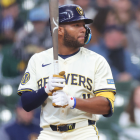The length of the average MLB game has become a rich source of hand-wringing. Sure, NFL games on average run a few minutes longer, include a halftime and boast about 11 minutes of actual football, but it's baseball's run times that get most of the negative attention.
To put this trend into perspective, let's take a look at the following chart, which shows the number of teams, per season, with an average game time of three hours or more.
Thanks to the handsome and necessary Baseball-Reference.com, we have game time data going back to 1947. It so happens that no team averaged 3:00 hours per game until the 1988 Yankees checked in at 3:02, so we begin our mining of the numbers with that season. Now here's what's happened since the '88 Yanks broke the seal ...
It's an upward drift, but it's not all that linear. The year 2000, in which run-scoring levels reached their highest mark since 1936, saw a very explicable leap (more offense generally yields longer run times). Then we saw another dip before the 3:00-hour game as the norm began a second rise in 2007. In 2012, exactly half of MLB's teams were averaging 3:00 or more hours per game. In 2013, we broke the 2000 record, and this season only one team -- the Mariners at 2:59 -- is averaging less than 3:00 hours per tilt. Related: This year's Rays are the first team to average at least 3:20 per game.
So if this wasn't a grave concern in, say, 2000, then why is it now? Well, in 2000 teams were scoring 5.14 runs per game. This season, they're scoring 4.10 runs per game, the lowest such figure since 1981. It's one thing to have lengthy games because crooked numbers are going on the board, but it's something else to have long games in the presence of, well, not much besides strikeouts.
Therein lies the problem. There are many reasons for baseball's current pacing problems -- batters' and pitchers' chronic stalling, the new replay system, too many pitching changes, longer commercial breaks, batters dedicated to working counts -- but it's more how the time is being spent that's a source of concern. Pacing needs to be improved, but the more complicated problem is structurally reducing the levels of time-sucking, offense-smothering strikeouts in the game right now. Much of what see above flows from the strikeout excesses of the contemporary game.
Yes, let's make players work briskly under pain of swift penalty, but let's also consider measures that limit the reliance on overly specialized relievers and that encourage making contact at the plate. That's how you whittle down those average game times.





















